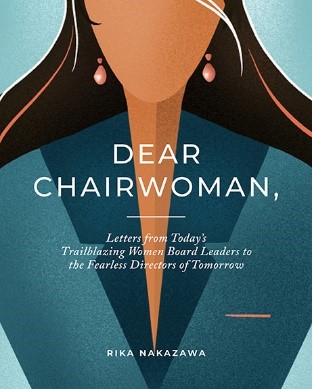“A CEO once said to me, ‘When a new fish is added to the fish tank, everybody swims differently.’”
“This is our moment of opportunity and obligation as citizens of the world. Women are desperately needed to balance the masculine energy already present in boardrooms.”
“Listen to what people are looking for and deliver what they want — but never lose sight of your value, especially the one that lies beyond boundaries.”
“Don’t be caught climbing the ladder of success … only to find that it was leading against the wrong wall.”
“Every great leader looks for diversity. It’s not just in our color and gender, but diversity in thought. If you have a room full of engineers, bring in an artist, a biologist, an economist, someone who thinks differently and will challenge the dominant mindset. Then, do it again.”
These are just a few of the soundbites from the book I recently published, “Dear Chairwoman.” Over a period of 18 months, I sought out, or was referred to, extraordinary and trailblazing women board leaders about their unique journeys to one of the most coveted leadership roles in enterprises and organizations: a seat at the boardroom table.
In both my direct conversations with these leaders, as well as in the process of converting the interviews into a letter form directed at the next generation of women board leaders, I was inspired by three major themes that emerged from the amazing stories of personal and professional triumph:
1. Know, and know how to express, your value.
As you progress through your career, you start to recognize where you have impact, and where and how you uniquely contribute towards a common goal for your team or your company. Along the way, it’s important to take the time to take stock of these skills and the outcomes you influence, and really start to appreciate the value you bring to an organization. And then, it’s not enough to just know your value; you also need to know how to articulate it, to package it in a way that can be easily and well understood to a new situation or group that’s next in your journey.
This often takes the shape of “self-promotion,” which is an exercise that’s often uncomfortable, especially for women. But it’s essential, as your busy colleagues — present or future — can’t know what your superpowers are unless you can clearly express them, especially with the usual noisy jostling that happens the higher up you go.
2. Don’t just network, cultivate your champions.
The adage, “It’s not what you know, it’s who you know” is more relevant than ever in an era of digital hyper-connectedness. Building a network is simply not enough to advance to the boardroom or other senior leadership forums. Historically, senior leadership roles have been filled through direct referrals. To paint a picture which may sound familiar to you anecdotally: Bill and Jim, senior executives in a common industry perhaps, are out golfing one weekend. On the seventh hole, Bill says, “Biggest headache these days has been the challenges we’re having with cybersecurity … we really need someone who knows this space to be on our board.” Jim picks up the pin for Bill’s putt and replies, “I think I know just the right guy for you.”
While this scenario is a bit of an oversimplification, even with the growth of executive recruitment for independent director roles, referrals are still the most common way that these seats get filled. These moments of social-but-professional interactions generate and build an asset I call “social capital.” While women in general have terrific social skills and thus have been good at “networking,” we’ve historically not had access to this “asset” — traditionally sourced on the golf course, sailing clubs, poker rooms, bars after work, etc. Fortunately, there are new forums available to build social capital, and it’s important to build those relationships that lead to this kind of advocacy, so that the next time Jim and Bill are chatting, Jim might say instead, “I think I know just the right person for you — she’s phenomenal in this area.”
3. Pull others up with you.
Many of the women I interviewed emphasized how critical it is to make sure we continue promoting the work of advancing gender balance in senior leadership even once we’ve stepped through those gilded executive doors ourselves. I heard several times how certainly the dynamics of the boardroom shifts some when a woman comes onto the board. However, the shift is even more dramatic and profoundly positive when there are three or more women on the board. Therefore, while the toil to break through various glass ceilings may be taxing in so many ways, we must continue the efforts to bring others up with us to ensure the current momentum towards greater diversity in senior leadership is truly sustainable. We still have a long way to go to achieve parity.
These are just a few of the gems that I gleaned on my book-writing venture. I hope they inspire you with the promise of a more inclusive future — in the boardroom and beyond.
Join Women in Retail Leadership Circle on Aug. 26 for a webinar on board readiness. Register for “Getting Board Ready: The Secrets to Landing a Board Seat and Being a Great Director” here. Registration is free for Women in Retail Leadership Circle members and $79 for nonmembers.

